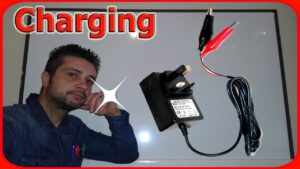Looking for the best way to charge a sealed lead acid battery? You’ve come to the right place! Charging a sealed lead acid battery correctly is essential to ensure its longevity and performance. In this article, we will delve into the most effective methods to charge this type of battery, providing you with the necessary knowledge to maintain and optimize its lifespan. Whether you are a beginner or an experienced user, understanding the best practices for charging these batteries is key. Let’s dive in and explore the world of charging sealed lead acid batteries!
What Is The Best Way To Charge A Sealed Lead Acid Battery
Introduction
Sealed lead acid batteries are widely used in various applications such as backup power systems, uninterruptible power supplies (UPS), and electric vehicles. To ensure their longevity and optimal performance, it is crucial to charge them correctly. In this article, we will explore the best practices for charging sealed lead acid batteries, including the charging process, charging methods, and important considerations.
Understanding Sealed Lead Acid Batteries
Sealed lead acid batteries, often referred to as SLA batteries, are rechargeable power storage devices that use lead and sulfuric acid. Unlike flooded lead acid batteries, SLA batteries are designed to be maintenance-free and do not require regular addition of water. They are sealed to prevent electrolyte leakage, making them safe for indoor use.
Charging Process
Before diving into the best way to charge a sealed lead acid battery, let’s briefly understand the charging process. The charging process can be divided into three main stages:
1. Bulk Charging: During this initial stage, the battery is charged at a constant current, typically around 10% of its capacity. The voltage gradually increases until it reaches its maximum level.
2. Absorption Charging: Once the battery reaches its maximum voltage, it enters the absorption stage. The charging current remains constant, but the voltage is held at the maximum level. This allows the battery to absorb the remaining charge and reach its full capacity.
3. Float Charging: After the absorption stage, the charger reduces the voltage to a lower level, known as the float voltage. This stage maintains the battery’s charge level and compensates for self-discharge.
Best Practices for Charging Sealed Lead Acid Batteries
1. Use a Suitable Charger
Using the right charger is crucial for the proper charging of sealed lead acid batteries. Here are some key considerations when selecting a charger:
- Ensure the charger is specifically designed for sealed lead acid batteries.
- Check the charger’s voltage and current ratings to match the battery specifications.
- Consider using a smart charger that provides automatic charging algorithms for optimal battery performance.
- Choose a charger with safety features such as overcharge protection and temperature monitoring.
2. Charge at the Correct Voltage
Charging a sealed lead acid battery at the correct voltage is essential for its longevity and performance. The recommended charging voltage for most SLA batteries is around 2.25 to 2.30 volts per cell or 13.5 to 13.8 volts for a 12-volt battery.
3. Avoid Overcharging
Overcharging can significantly reduce the lifespan of a sealed lead acid battery. To prevent overcharging:
- Use a smart charger with built-in overcharge protection.
- Set the charger to the correct charging voltage and limit the charging time if manual control is required.
- Regularly monitor the battery voltage during the charging process.
4. Temperature Considerations
Temperature plays a crucial role in the charging process of sealed lead acid batteries. Here’s what you need to keep in mind:
- Avoid charging the battery in extreme temperatures, as it can affect the battery’s capacity and overall performance.
- Consider using a charger with temperature compensation to adjust the charging voltage based on the battery’s temperature.
- Allow the battery to cool down before charging if it has been subjected to high temperatures.
5. Avoid Deep Discharges
Deep discharges can harm sealed lead acid batteries and reduce their lifespan. To avoid deep discharges:
- Implement a regular charging schedule to maintain the battery’s charge level.
- Avoid leaving the battery discharged for extended periods.
- Consider using a battery management system that provides low voltage cutoff protection.
6. Equalization Charging (Optional)
Equalization charging is an optional step that can be performed on SLA batteries to balance the voltage levels among the battery cells. It helps to maintain the battery’s capacity and mitigate the effects of voltage imbalance. Not all SLA batteries require equalization charging, so it’s important to consult the manufacturer’s guidelines.
Properly charging a sealed lead acid battery is crucial for its longevity, performance, and safety. By following the best practices outlined in this article, such as using a suitable charger, charging at the correct voltage, and avoiding overcharging, you can ensure that your sealed lead acid battery serves you reliably for a long time. Remember to also consider temperature, avoid deep discharges, and check if equalization charging is recommended for your specific battery type. By taking these steps, you can maximize the lifespan and optimize the performance of your battery.
How to Charge a Battery–lead acid and lithium-ion batteries (2021)
Frequently Asked Questions
What is the best way to charge a sealed lead acid battery?
A sealed lead acid battery should be charged using a controlled charging method to ensure its longevity and optimal performance. Here are some key considerations:
How should I choose a suitable charger for my sealed lead acid battery?
When selecting a charger for your sealed lead acid battery, it is important to consider the battery’s voltage and capacity. Look for a charger specifically designed for sealed lead acid batteries, with features such as adjustable voltage and current settings.
What charging method should I use for my sealed lead acid battery?
The most common charging method for sealed lead acid batteries is the constant voltage method. This means applying a constant voltage to the battery while adjusting the charging current based on the battery’s state of charge. It is important to follow the manufacturer’s guidelines and recommendations for your specific battery model.
Should I use a trickle charger or a fast charger for my sealed lead acid battery?
For optimal charging, it is generally recommended to use a multi-stage charger that offers both a bulk charging phase and a float charging phase. This allows for a faster initial charge without overcharging the battery, and then switches to a maintenance mode to keep the battery fully charged without causing damage.
How long does it take to fully charge a sealed lead acid battery?
The charging time for a sealed lead acid battery depends on its capacity and the charging current. As a general guideline, it can take anywhere from several hours to overnight to fully charge a sealed lead acid battery. It is important to avoid overcharging, so monitoring the charging process and using a charger with automatic shutoff or float mode is recommended.
Can I leave a sealed lead acid battery on a charger indefinitely?
While sealed lead acid batteries are designed to handle continuous charging, it is not recommended to leave them on a charger indefinitely. Overcharging can lead to decreased battery life and can potentially damage the battery. Once the battery is fully charged, it is best to disconnect it from the charger, or switch to a maintenance mode if available.
Final Thoughts
Charging a sealed lead acid battery requires a careful and precise approach to ensure optimal performance and longevity. The best way to charge a sealed lead acid battery is to use a dedicated charger specifically designed for this type of battery. These chargers typically employ a three-stage charging process: bulk, absorption, and float. It is crucial to follow the manufacturer’s guidelines regarding charging parameters, such as voltage and current limits. Additionally, regular maintenance, such as equalization charging and avoiding deep discharges, can help extend the battery’s lifespan. By following these guidelines, you can ensure the best performance and durability for your sealed lead acid battery.



